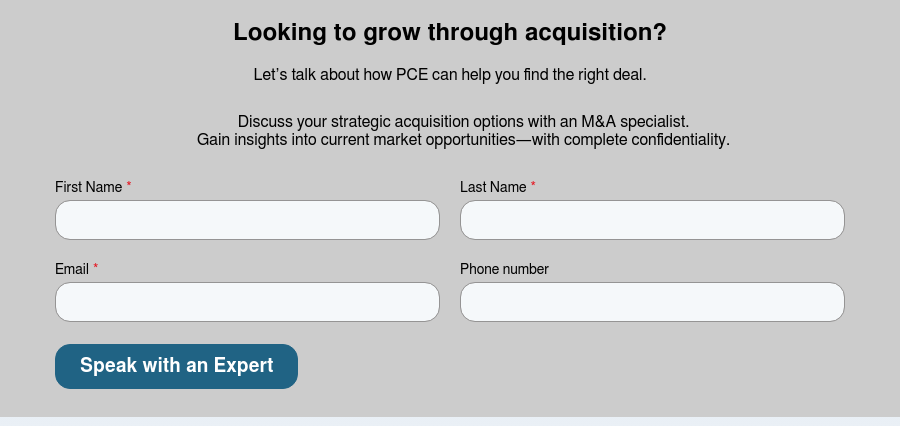Industry Trends
Largest Transactions Closed
- Target
- Buyer
- Value($mm)

Expansion through acquisitions can be a compelling strategy to accelerate growth, but you will only be successful when you start your integration planning early and stay dedicated to executing your integration plan after the transaction closes. With proper planning and execution of your integration strategy, you may see the deal value increase by 6% to 12%, according to estimates by McKinsey & Company.1 To learn more, explore our guide on executing your M&A integration plan."
Both the planning and the execution stages of an M&A integration are essential — this article will focus solely on the planning phase while a second article will cover the post-acquisition integration phase. Most experts agree that planning should start as early as the due diligence phase of a transaction. Below, you’ll find a guide to creating your integration plan. (Be mindful of potential issues by reviewing our resource on red flags in the acquisition process.)
Engagement from your management team is paramount for a successful M&A deal. When leaders buy into the acquisition strategy, they help foster support and energy throughout the integration planning and execution process. Instead of waiting until after the acquisition, create an integration team as soon as you have found a potential business to buy. This will allow you to continue concentrating on running your business while the team focuses on the integration process. Discover additional insights on leveraging an investment banker for your acquisition strategy.
The integration team should include your Chief Financial Officer, Chief Operating Officer, Human Resources Director, and Chief Technology Officer, as well as members of each of their divisions. A strong integration team will lead efforts to identify synergies, maintain positive communication with potential target companies, and create an overall integration plan so that you are ready to hit the ground running after the close.
As part of the integration plan, the team should develop a defined timeline with milestones mapped out and assigned to members of the team. Empower these team members to take control of their assignments and hold them accountable for achieving plan goals. Establish weekly meetings to check in with the team so that everyone is aware of the progress that is being made and any necessary adjustments can be easily identified.
Revenue growth is typically the driving force behind an acquisition. (Read more about how strategic acquisitions can fast-track your business growth.) When evaluating an acquisition, you should determine how the acquired company will foster revenue growth. If there isn’t a path to growth, you will need to focus on cost savings to create a more profitable enterprise. Ideally, the acquisition will generate both growth and cost savings.
Questions you and your team need to ask and answer include:It is important to thoroughly analyze the various growth opportunities for the target company in order to realize the maximum benefit of the acquisition. The questions above should be fleshed out by your integration team prior to completion of the acquisition so any changes can be planned out and ready for implementation on day one.
It is critical that you understand the cost structure of the business you acquire. Confirm that the business you are seeking to acquire is scalable and that you can operate it more efficiently. Identify the synergies you would like to achieve and any additional expenses you may incur. Common questions you should ask include:
After you have reviewed the cost savings or increases related to the acquisition, create a pro forma budget to make sure the business is still achieving the level of profitability you were expecting.
Determine what needs to be done to merge an acquired business’s systems and platforms with the platforms you use. Your current software platform providers will likely have experience in completing integrations from whichever platform the seller uses to your platform. Check with your vendors to see if they can provide support during this process. If your software company doesn’t have prior experience in merging the IT platforms, you will need to determine how to export the data from the acquired company’s software and import it into your systems.
Bring experts from your existing IT team and business systems team into the decision-making process to discuss how to migrate the other company’s data, such as the company’s vendors, customers, employee records, financial records, and other material information. Be aware that it might not be possible to extract the data from the acquired company’s IT platform into a usable backup or for migration into your software platform. In these cases, you may choose to keep a license for the acquired company’s platform for a set number of years to ensure the company’s records are available as needed for regulatory or tax purposes.
As discussed above, analyze the employee census of the company, how employees are compensated, and the benefits the business provides. Be prepared to compare these benefits to those your company provides. Create an analysis of the impact these will have on the business’s financial performance once you acquire it. Adjust any forecasts for these differences to get a realistic performance expectation. Review your workforce and identify employees who can absorb added responsibilities — this will help you determine which positions at the target company are unnecessary.
Plan welcoming orientation sessions for your new employees. Encourage team members to be inclusive and discuss any benefit changes, the organizational hierarchy, and your growth plans for the business. Employee uncertainty is always a concern during an integration, so have these orientation sessions ready in order to keep employees excited and encouraged about their new career path.
The more you can engage with employees prior to the acquisition, the stronger their bond with you will be. It is unrealistic to meet all the employees prior to closing, but aim to meet as many key people as possible. If the leaders of the target company show enthusiasm about the acquisition, their colleagues will be excited as well.
Integrating a new business into your existing company is a challenging task. However, if executed properly, it can provide a great return for your company. As Benjamin Franklin famously said, “By failing to prepare, you are preparing to fail.” Taking key steps to establish a team to lead your acquisition strategy and creating a timeline of events and milestones will solidify the acquisition process and set your company up for success. By developing a coherent integration plan, your team will recognize that integration doesn’t start when the legal documents are signed but instead begins with learning about the company and comprehensively analyzing how the business will fit into yours.
Your integration team will also allow you to continue to focus on your core business and ensure that it is still meeting its own growth goals. Rely on your team to take care of most of the integration work. Focus on keeping the seller engaged in the process and aim to prevent any fundamental personnel changes that would hinder the projected growth of the company you are acquiring. Make sure you have clear acquisition goals and consider hiring an investment banker to help you streamline the process to ensure your acquisition is as smooth as possible.

Nicole Kiriakopoulos
Nicole Kiriakopoulos is a Director at PCE, supporting clients through buy-side and sell-side M&A transactions. With nearly 20 years of experience and a focus on facility services, she has advised on more than 100 deals totaling over $1 billion in value.
1. “How the best acquirers excel at integration,” by Rebecca Doherty, Oliver Engert, and Andy West, McKinsey & Company, January 1, 2016.
Investment Banking
New York Office
201-444-6280 Ext 3 (direct)
mmoran@pcecompanies.com
Connect
201-444-6280 Ext 3 (direct)
407-621-2199 (fax)